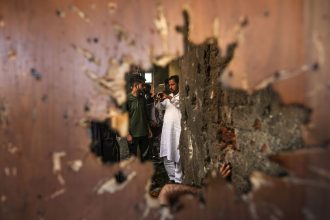India-Pakistan Joint Interview Pt. 2 “A Generation That Has Dreamed of Peace, Not War — Breaking the Cycle of Hatred”
As the founding president of Asia Journalist Association and publisher of THE AsiaN, I have built a long-standing friendship with journalists from India and Pakistan. I have also seen them form bonds that transcend national boundaries by meeting journalists from both countries in one place.
However, the recent conflict between the two countries has become serious since the recent Kashmir terror attack. The governments of both countries, as well as the media, have continued to criticize each other harshly, and the situation is getting worse.
In response, THE AsiaN conducted two joint interviews with Gunjeet Sra, an Indian journalist and Nasir Aijaz, a Pakistani journalist, before and after the ceasefire between the two countries, in order to provide readers with an in-depth and balanced perspective.
THE AsiaN handed out the same questions to the journalists from both countries on topics such as ‘terrorism across the border,’ ‘temporary ceasefire,’ ‘local atmosphere,’ ‘media’s perspective on the situation,’ and ‘realistic solutions. THE AsiaN received written responses. The interviews conducted in Q&A format will be published in two parts in the English and Korean editions of THE AsiaN.
Since the terrorist attack in Kashmir that triggered the current situation, both governments and media outlets have been engaged in mutual condemnation. How is the media in your country portraying and interpreting this crisis?
Gunjeet Sra: In India, the media’s coverage of the crisis has been intense, often highly dramatic and deeply patriotic. Major television networks and newspapers have focused heavily on national security narratives, frequently portraying the situation as a test of India’s strength. There is widespread condemnation of Pakistan, and the rhetoric tends to be emotionally charged, leaving little room for nuance or critical analysis of the broader strategic picture.
Although there has been some media which has approached the subject of war by trying to humanise it. There have been stories from border towns, where civilians have suffered due to shelling or displacement. Reports have featured the struggles of common
people—schoolchildren, and families living near the LoC—who are caught in the crossfire, emphasising the emotional and human cost of continued hostilities.
While these stories evoke empathy and national pride, the coverage often avoids asking tough questions about policy, long-term strategy, or the consequences of escalation.
Nasir Aijaz: Media in both countries tend to frame the conflict through nationalistic lenses. Indian outlets often emphasize terrorism and security concerns, while Pakistani media highlight Kashmir’s self-determination and criticize perceived Indian aggression. This mutual depiction perpetuates suspicion and hampers mutual understanding.
The unchecked spread of misinformation and fake news has been cited as one of the factors that worsened the situation. Are there any specific examples that illustrate this issue?
Gunjeet Sra: Yes, misinformation has significantly worsened the crisis and heightened public anxiety. In the days following the military attacks, a wave of unverified content flooded social media and even mainstream channels, often without proper fact-checking. One striking example was the viral rumor that India had launched or was planning to attack a Pakistani nuclear facility—a claim with no credible basis, but which caused widespread panic online and even trended on social media for hours before it was debunked.
Another major instance involved the false claim that a female Indian Air Force pilot had been captured by Pakistan. This story gained traction rapidly, with social media posts and some lesser-known news outlets sharing photos and narratives to support the claim. It was later confirmed to be entirely untrue.
In addition, old videos from unrelated conflicts were circulated. Some outlets reported inflated casualty numbers or fabricated retaliatory strikes, which created confusion and led to misinformed speculation about the government’s next step.
This unchecked spread of fake news blurred the line between fact and fiction.
Nasir Aijaz: Yes, there have been false reports on social media claiming military movements, civilian casualties, or secret deals, which stir panic and outrage. For example, fake videos or misleading images suggesting mass attacks without verification have circulated rapidly, fueling hostility and misinformation.

Unlike older generations who remember war, younger people in both countries seemed to be moving away from hostility. How do you think this conflict will impact the younger generation?
Gunjeet Sra: For many years, the younger generations in India and Pakistan dared to dream differently. They grew up not with memories of war, but with hopes of peace. They followed the same music, watched the same films, connected on social media, and began to see each other not as enemies—but as people. As human beings. I think, most people in both countries do realise that this war is not a war that they want and want to choose empathy over enmity. If we let this conflict define their worldview, we will raise a generation that inherits hatred instead of healing. And that may be the greatest tragedy of all.
Nasir Aijaz: Younger people tend to be less hostile and more optimistic about the future. They often advocate for dialogue, peace, and development, recognizing the devastating toll conflict has taken on their communities. Their attitudes could shape future relations if positive engagement continues. Certainly, all the people are patriots, and wouldn’t support aggression by any other country, but they are not hostile to India.
In the past, the two countries promoted peace through cricket matches and cultural exchanges. In today’s context, what do you think could be a realistic approach to conflict resolution?
Gunjeet Sra: Terrorism has cast a long shadow over trust and yet, we cannot let the dream of peace die. A realistic approach now must begin with accountability and truth. Pakistan must first take credible, visible action against terror networks operating on its soil. There can be no honest conversation until the violence ends.
Once that threshold is crossed, we must rebuild from the ground up. Not through flashy summits, but through quiet, consistent engagement: academic collaborations, joint environmental initiatives, digital youth forums, and humanitarian cooperation. Let artists and educators take the lead again. Let young people build bridges.
We need peace not just in policy, but in perception. Peace that is rooted in security, strengthened by dialogue, and inspired by shared history.
Nasir Aijaz: Beyond symbolic gestures like sports and cultural exchanges, pragmatic steps include sustained diplomatic negotiations, confidence-building measures, economic cooperation, and people-to-people contact. International mediation and accords on local governance and human rights could pave the way for lasting peace.
As citizens and journalists from the countries directly involved, what message would you like to convey to the people of the other nation?
Gunjeet Sra: I know many long for peace. And while we have both inherited pain we didn’t choose, we don’t have to pass it on.
India’s anger is not toward Pakistani people, but toward the forces that keep us divided and in fear. Every act of terror is a wound to the peace we both deserve. We share the same sky, the same roots, and the same hope for a better future. Let us amplify our voices, not for war but for truth and compassion.
Nasir Aijaz: I would ask for understanding, compassion, and the recognition that at the core, we share hopes for peaceful lives and progress. Despite political differences, human empathy and dialogue are essential to overcoming hostility and building a future based on mutual respect and coexistence.
(End)
Link to Korean article : [인도-파키스탄 기자 공동인터뷰 2] “전쟁 대신 평화 꿈꿔온 젊은 세대, 증오의 대물림 막아야” – 아시아엔 THE AsiaN




